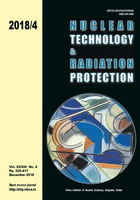
FIFTEEN YEARS OF OCCUPATIONAL EXPOSURE MONITORING IN THE FEDERATION OF BOSNIA AND HERZEGOVINA

Vol.
XXXIII, No. 4, Pp. 325-417
December 2018
UDC 621.039+614.876:504.06
ISSN 1451-3994
Pages: 395-405
Authors: Begzada BašiŠ, Adnan BeganoviŠ, Maja GazdiŠ-ŠantiŠ, Amra Skopljak-BeganoviŠ, and Davorin SamekAbstract
The personal dosimetry in Bosnia and Herzegovina started in 1960. After a brief interruption in 1990s, the dosimetry service resumed in 1999. Until 2013, the Radiation Protection Centre of the Institute of Public Health of Federation of Bosnia and Herzegovina has been the only institution in the country that could provide this service. In 2013, this Center covered more than 70 % (1,485) of all radiation workers in the country. They mostly worked in medical institutions (1,417 or 95.4 %), while others are exposed to radiation sources in industry and veterinary radiology. From 1999 to 2013, the majority of annual doses were less than 1 mSv (96.2 %). There are no registered cases of exceeding the annual dose limit (20 mSv). The results analysis shows the reduction of individual doses in last five years. Newly adopted practices in medicine, such as the positron emission tomography, could cause the increase of doses in the years to come.
Key words: occupational exposure, dosimetry, thermoluminescence dosimetry
FULL PAPER IN PDF FORMAT (1.26 MB)